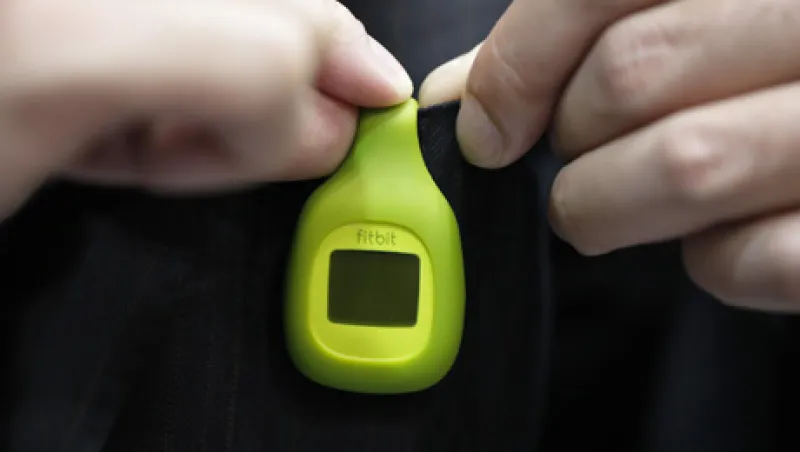Wearable technology — devices that measure activity and then upload the data to a smartphone or web site — made nearly all of the 2014 year-end trend lists. Wearables are everywhere you look, from tech news to a new Netflix offering of the television series Black Mirror — one episode of which imagines a world in which almost everyone wears a medically implanted memory chip called a grain. Grains, and other unsleeping sensor arrays, aren’t science fiction. They put one in mind of something like the Narrative Clip 2, a tiny camera that collects regular photographs of the wearer’s every moment and which premiered at the 2015 Consumer Electronics Show in Las Vegas earlier this month. Monitoring and quantifying every aspect of our lives are the order of the day: The year to come will continue to show us the rise of the Fitbit, the Apple Watch and the dozens of other products we can now carry about with us on our persons as easily and thoughtlessly as a bracelet or a T-shirt.
Fittingly, CES focused on the intersection of health and technology, on what you might call the body physical and the body electronical. Google Glass may be floundering, but dozens of other companies are producing their own ways of outfitting consumers with the means to track their sleep, their nutrition, the calories they burn and a vast array of other stats. WebMD — which clearly has a great deal to gain from convincing consumers that technology can help them manage and improve their health — has come out in favor of providing patients with wearable sensors for more accurate blood pressure monitoring, among other uses. BlueStar, an app created by Baltimore-based health care company WellDoc, enables people to monitor their diabetes using blood glucose levels, medications, diet and exercise.
The desire for such products is ravenous, and investors’ expectation that they are necessary to keep any company at the cutting edge is very clear: Apple experienced a massive drop in its stock price after the iPhone maker failed to introduce a watch during a developers’ conference in June 2014 (the September announcement of the Apple Watch and Apple Pay solved the problem, and then some). So how do investors find the best opportunities to tap into wearable tech? And who will stand to benefit most from the billions of dollars that have poured into and will keep pouring into wearable technology during 2015?
There are the large apparel retailers that are trying to tap into the trend by retrofitting their products and their brands — and that might experience some lift, however minuscule, from including wearables in their product lines or their marketing. This is especially true of any company positioned anywhere close to fitness or leisure apparel: Victoria’s Secret and Adidas both sell sports bras equipped with sensors (Adidas’s has been on the market since 2012). Ralph Lauren recently released a smart polo shirt and plans to put out a smart dress shirt. Worth noting, however, is that the tech here seems very low: These are simply shirts with microchips woven into them, no more advanced than a standard fitness armband. One wonders if consumers will bother to spend more money on a Polo Tech when they can wear a Fitbit — the ideas here are vaguely reminiscent of the backpacks that contained special pockets for Walkman CD players and no one ever used.
Even Coca-Cola has invested in wearable technology: Its strategic marketing ventures team partnered with Misfit to produce a branded version of its Shine wearable called Flash Fitness, a supposedly more stylish way for consumers to monitor their activity and calorie intake (important, of course, for a company whose flagship product is famously unhealthy and stood at the center of government efforts to ban sodas from vending machines in public schools in New York and other cities).
Investors might look to those manufacturers and suppliers responsible for the components of wearables, including screens, sensors and bands. Investors were already burned by attempting to keep abreast of the Apple Watch parts suppliers when GT Advanced Technologies — which was to have been responsible for its sapphire glass screens — filed for Chapter 11 in late 2014. Nonetheless, sensor manufacturers like San Jose, California–based InvenSense and flexible LED screen manufacturers like Ewing, New Jersey–based Universal Display Corp. might benefit from wearable technology fever.
The last angle is attempting to find those wearable tech producers — in some cases, software companies — that will help consumers make sense of the data their sensors collect. Proper data analysis turns raw numbers into useful forecasts, versus simply informing users that they ate too much or slept too little but allowing them to accurately and thoroughly understand, for instance, how one week’s diet will affect the next week’s performance at work — or how their overall metabolism might change from month to month, affecting what they can and can’t eat without gaining weight. According to the Guardian, the fitness bands made by Jawbone, Intel’s Basis and Fitbit are all attempting to offer their users more meaningful analysis; of the three, Intel is the only public opportunity.
Nonetheless, a truly savvy investor will keep his or her eye on the start-up world, including those wearable products and companies emerging out of crowdfunding sites — Kickstarter, Indiegogo and the microfunding site Tilt.com. Coca-Cola’s partnership with Misfit came after Shine was crowdfunded on Indiegogo, attracting the attention of larger players. (The most successful crowdfunding campaign of all time was the Pebble Watch, via Kickstarter). Many new trends now surface within the crowdfunding community, where the obstacles involved in securing a single large investment to prototype a product are removed: For wearables, wise investors might look there to identify — among private and start-up companies — the trends that public companies adopt and are likely to follow.





